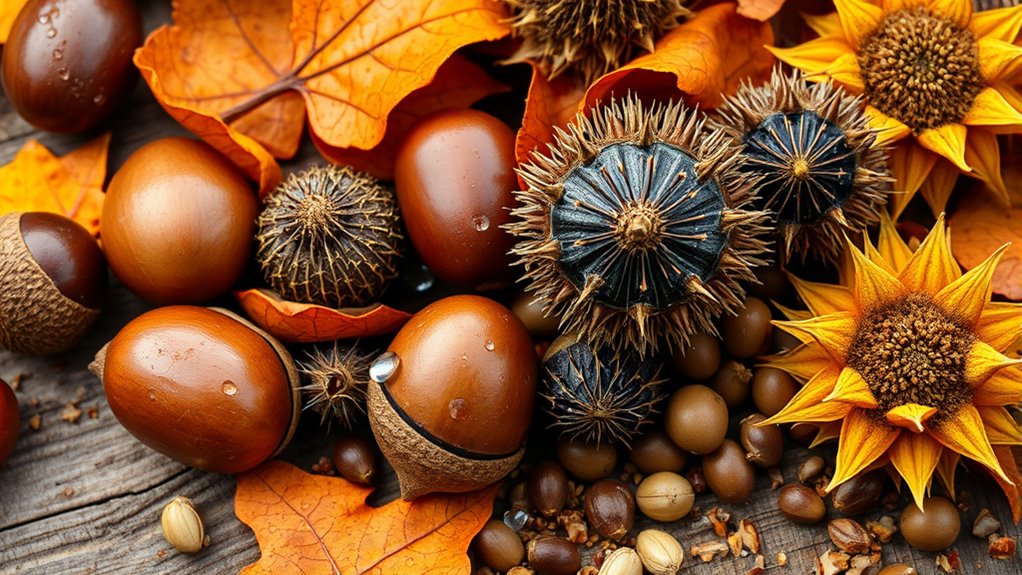This autumn, you should gather chestnuts, acorns, pumpkin seeds, sunflower seeds, and hazelnuts. Collect fallen chestnuts and acorns soon after they drop, ensuring they’re mature and free of damage. Roast or process them for snacks or cooking. Save pumpkin and sunflower seeds from seasonal produce by roasting or adding them to dishes. Pick ripe hazelnuts when the husks turn brown and split open. Keep exploring for more tips on collecting these tasty, nutritious treasures.
Key Takeaways
- Gather fallen chestnuts in autumn, ensuring shells are scored before roasting, and store in a cool, dry place or refrigerate.
- Collect mature acorns with smooth shells and brown color, then remove shells and leach tannins for safe eating.
- Pick pumpkin seeds from ripe pumpkins, clean thoroughly, and dry or store in airtight containers for later use.
- Harvest sunflower seeds once the flower heads turn brown and seeds are fully developed; dry before storing.
- Collect hazelnuts when husks turn brown and split, then remove shells carefully to enjoy fresh, crunchy nuts.
Chestnuts: The Classic Autumn Nut
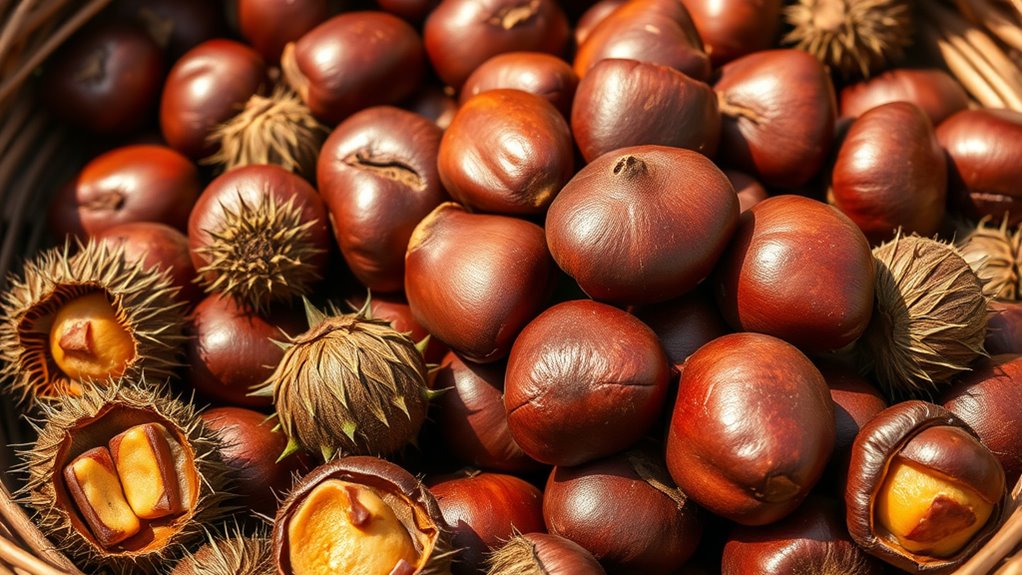
Chestnuts are a quintessential symbol of autumn, loved for their sweet, nutty flavor and warm, comforting aroma. When gathering chestnuts, consider how you’ll use them in cooking recipes like roasted chestnuts or stuffing. To prepare, score the shells before roasting to prevent bursting. Once cooked, you can enjoy them immediately or incorporate them into various dishes. Proper storage tips are essential to keep chestnuts fresh; keep them in a cool, dry place or refrigerate in an airtight container for up to a week. For longer storage, freeze the shelled nuts, ensuring they’re completely dry beforehand. This way, you’ll preserve their flavor and texture, making them a versatile ingredient throughout the season.
Acorns and Oak Tree Seeds for Foraging
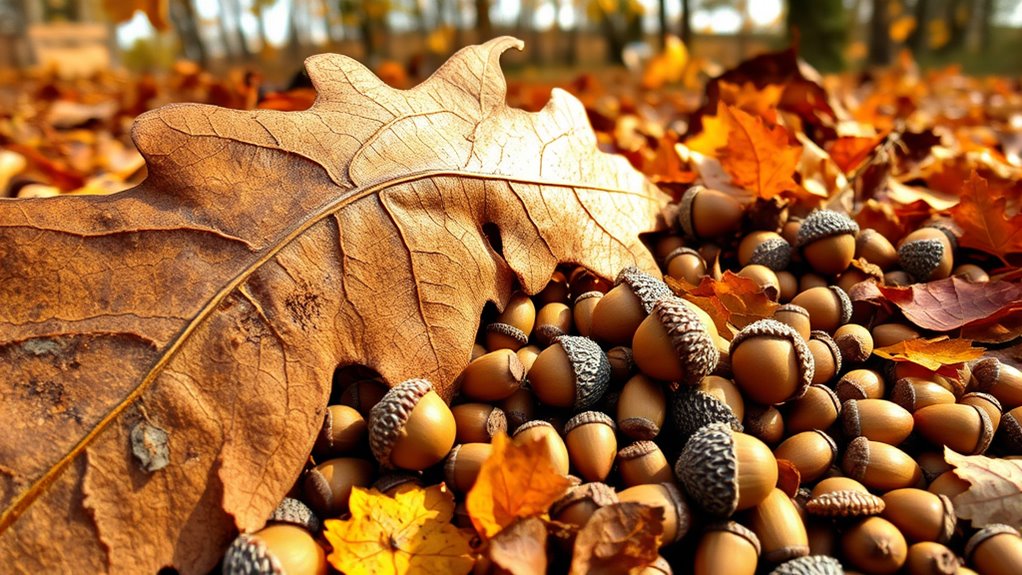
Have you ever considered foraging for acorns and oak tree seeds as a wholesome autumn activity? If so, start with acorn identification to distinguish edible varieties from those with high tannin levels. Look for mature acorns that have turned brown and have a smooth shell. You’ll notice that acorns drop in a specific pattern, aiding in understanding oak seed dispersal. Gathering fallen acorns from under oak trees is best done soon after they fall, ensuring they’re fresh and viable. Be mindful of squirrels and other wildlife that also collect these seeds. Once collected, you can process acorns by removing shells and leaching out tannins, making them suitable for baking or snacking. Foraging acorns is a rewarding way to connect with nature while harvesting a versatile, seasonal resource. Additionally, understanding the role of acorns in cultural and ecological contexts can enrich your foraging experience.
Pumpkin Seeds: A Seasonal Superfood
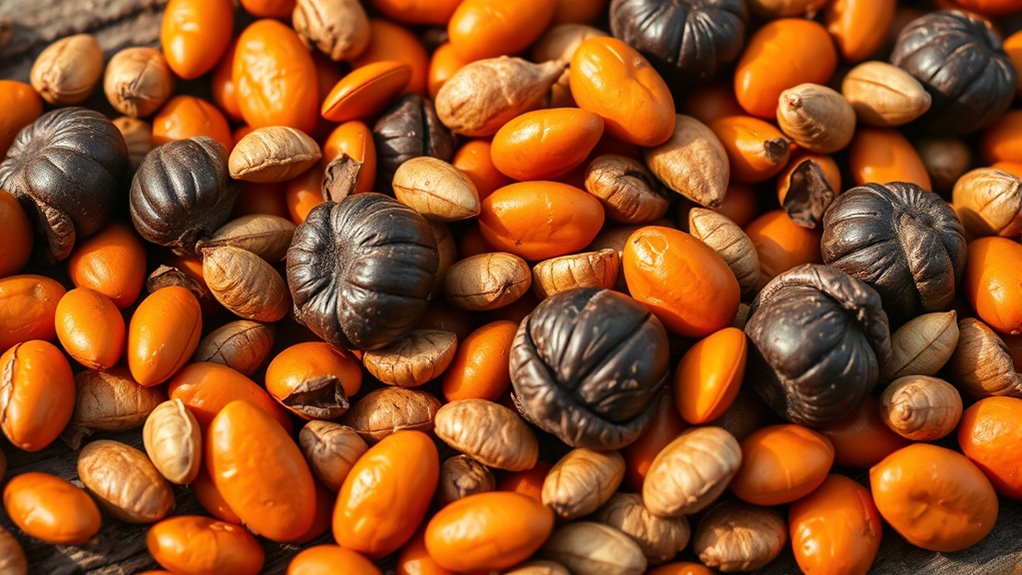
As autumn arrives, pumpkin seeds emerge as a delicious and nutritious seasonal superfood. You can enjoy them roasted, raw, or added to salads and granola. Their rich flavor pairs well with nut butters like almond or peanut, enhancing snacks or spreads. To keep pumpkin seeds fresh, store them in an airtight container in a cool, dark place, or refrigerate for longer shelf life. When exploring nut butter pairings, consider combining roasted pumpkin seeds with honey or cinnamon for added flavor. Use seed storage methods like vacuum sealing if you want to preserve their crunch and freshness. These versatile seeds not only boost your nutrition but also add texture to your autumn dishes. Incorporate pumpkin seeds into your seasonal diet for a tasty, wholesome treat.
Sunflower Seeds and Their Versatile Uses

Sunflower seeds are a versatile snack and ingredient that can enhance both your meals and baking. You can enjoy them roasted and salted as a quick, nutritious snack or sprinkle them over salads and yogurt for added crunch. Their rich flavor makes them perfect for baking bread, muffins, and granola bars. Additionally, sunflower seeds are a key ingredient in producing sunflower oil, which is great for cooking and dressings. Don’t forget, sunflower seeds also serve as excellent bird feed, attracting backyard birds with their high fat content. Whether you’re using them in the kitchen or for your feathered friends, these seeds offer endless possibilities. Incorporating sunflower seeds into your autumn routine can also be a protective styling benefit by adding nutritious flair to your seasonal foods and activities.
Hazelnuts and Filberts: Rich, Crunchy Goodness

You’ll want to understand how hazelnuts are harvested to get the best quality. Filberts pack a nutritional punch, offering healthy fats, vitamins, and minerals. Knowing these details helps you appreciate their rich, crunchy goodness even more. Additionally, proper harvesting techniques ensure the nuts maintain optimal moisture levels and quality during storage self watering plant pots.
Harvesting Techniques for Hazelnuts
Harvesting hazelnuts requires timely action to guarantee the nuts are ripe and at their peak flavor. When the husks turn brown and begin to split, it’s time to harvest. Use pruning shears or a sturdy ladder to reach the highest branches safely, gathering the nuts by hand or with a nut rake. After collecting, focus on shell removal techniques: you can crack the shells with a nutcracker or gently pound them with a hammer, being careful not to crush the nut inside. For easier shell removal, some growers soak the nuts in water for a few hours to loosen the shells. Proper timing and these shell removal techniques ensure you enjoy fresh, crunchy hazelnuts with minimal effort.
Nutritional Benefits of Filberts
Hazelnuts, also known as filberts, pack a powerful nutritional punch, making them a nutritious addition to your diet. They are highly nutrient-dense, providing essential vitamins, minerals, and healthy fats in a small serving. These nuts are rich in vitamin E, which supports your immune system and skin health, while their fiber content aids digestion. Hazelnuts also boast impressive antioxidant properties, helping to combat oxidative stress and reduce inflammation. Consuming them regularly can contribute to heart health, thanks to their monounsaturated fats that help lower bad cholesterol levels. Their crunchy texture makes them a satisfying snack that delivers concentrated nutrition. Incorporating filberts into your meals or snacks boosts your nutrient intake and offers health benefits backed by their dense, antioxidant-rich profile. Additionally, including a variety of nutritious foods in your diet can enhance overall health and well-being.
Pine Nuts and Other Conifer Seeds to Collect
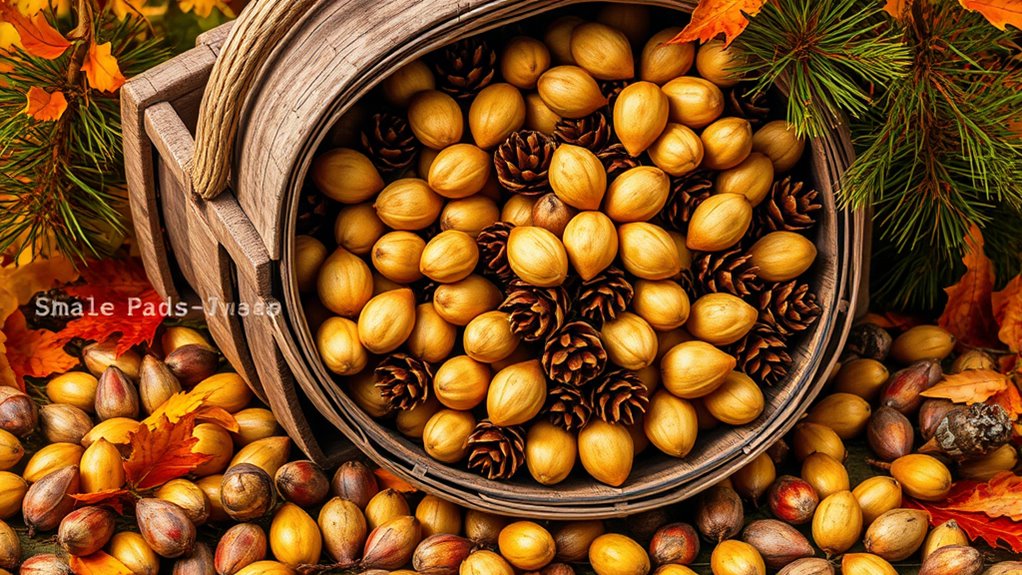
Pine nuts and other conifer seeds are valuable autumn treasures that can be collected directly from the trees or the forest floor. Conifer seed collection involves carefully gathering seeds from mature cones, which often fall naturally, making pine cone harvesting easier. Look for cones that have opened slightly or are on the ground, revealing the hidden seeds inside. When harvesting, use gloves to protect your hands from sharp scales and avoid damaging the tree. Shake or tap branches gently to encourage cones to drop. For the best yield, focus on pines like the stone pine or Korean pine, known for their edible seeds. These seeds are not only delicious but also pack a nutritious punch, making your efforts well worth it. Recognizing the nutritional value of these seeds can enhance their value in your diet.
Frequently Asked Questions
When Is the Best Time to Harvest Each Type of Nut?
You want to know the best time to harvest each type of nut. Generally, harvesting timelines depend on the nut’s variety and your local climate. Seasonal best practices suggest waiting until the outer shells or husks split naturally, indicating ripeness. Keep an eye on the nuts’ firmness and color. By timing your harvest correctly, you guarantee maximum flavor and storage quality, making your efforts worthwhile.
How Do I Identify Edible Versus Toxic Acorns?
Identifying edible acorns is like finding hidden treasure among fallen leaves. To tell edible from toxic, look for smooth, shiny caps and a rich brown color—avoid ones with mold or holes. Always follow safe foraging tips and compare your findings with edible mushroom identification guides, as some acorns can be toxic if improperly prepared. When in doubt, consult an expert before consuming wild acorns to guarantee safety.
What Are the Nutritional Benefits of Autumn Seeds?
Autumn seeds are packed with nutritional antioxidants that boost your immune system and fight free radicals. They provide essential healthy fats, protein, vitamins, and minerals that support your overall health. By incorporating seeds like sunflower, pumpkin, and chia into your diet, you can enjoy these health benefits while adding flavor and crunch to your meals. Their rich nutrient profile makes them a smart choice for maintaining energy and wellness during the season.
How Should I Store Gathered Nuts and Seeds?
Storing your nuts and seeds properly is vital—think of it as guarding treasure from the ages. To guarantee seed preservation, keep them in airtight containers in a cool, dark, and dry place. Use nut storage techniques like refrigeration for longer shelf life or freezing for extended preservation. Avoid humidity and direct sunlight, which can cause spoilage. With these steps, your autumn bounty stays fresh and nutritious for months.
Can I Grow New Trees From Collected Nuts and Seeds?
Yes, you can grow new trees from collected nuts and seeds through seed propagation, but success depends on the seed type and planting conditions. For tree cultivation, start by cleaning and stratifying the seeds if needed, then plant in well-draining soil at the right depth. Keep the soil moist and provide suitable sunlight. With patience and proper care, you’ll nurture healthy saplings that can grow into mature trees.
Conclusion
As autumn paints the world with warmth and abundance, gathering these nuts and seeds feels like collecting tiny treasures from nature’s bounty. Each one offers a unique flavor and story, waiting to be enjoyed or preserved. Think of your collection as a colorful mosaic, each piece adding richness and texture to your season. Embrace this time of harvest, and let these natural gems nourish both your body and soul through the cooler months ahead.

